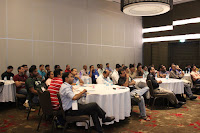Below is the abstract, slides and video from the talk.
Abstract
The key objectives of any organization is to provide / derive value from the products / services they offer. To achieve this, they need to be able to deliver their offerings in the quickest time possible, and of good quality!
In such a fast moving environment, CI (Continuous Integration) and CD (Continuous Delivery) are now a necessity and not a luxury!
There are various practices that organizations need to implement to enable CD. Changes in requirements (a reality in all projects) needs to be managed better. Along with this, processes and practices need to be tuned based on the team capability, skills and distribution.
Testing (automation) is one of the important practices that needs to be setup correctly for CD to be successful. But, this is tricky and requires a lot of discipline, rigor and hard work by all the team members involved the product delivery.
All the challenges faced in smaller organizations get amplified when it comes to Enterprises. There are various reasons to this - but most common reasons are - scale, complexity of the domain, complexity of the integrations (to internal / external system), involvement of various partners / vendors, long product life-cycles, etc.
In such situations, the Testing complexity and challenges also increase exponentially!
Learn, via a case study of an Enterprise, a large Bank, the Testing approach required to take them on the journey to achieving CD.












